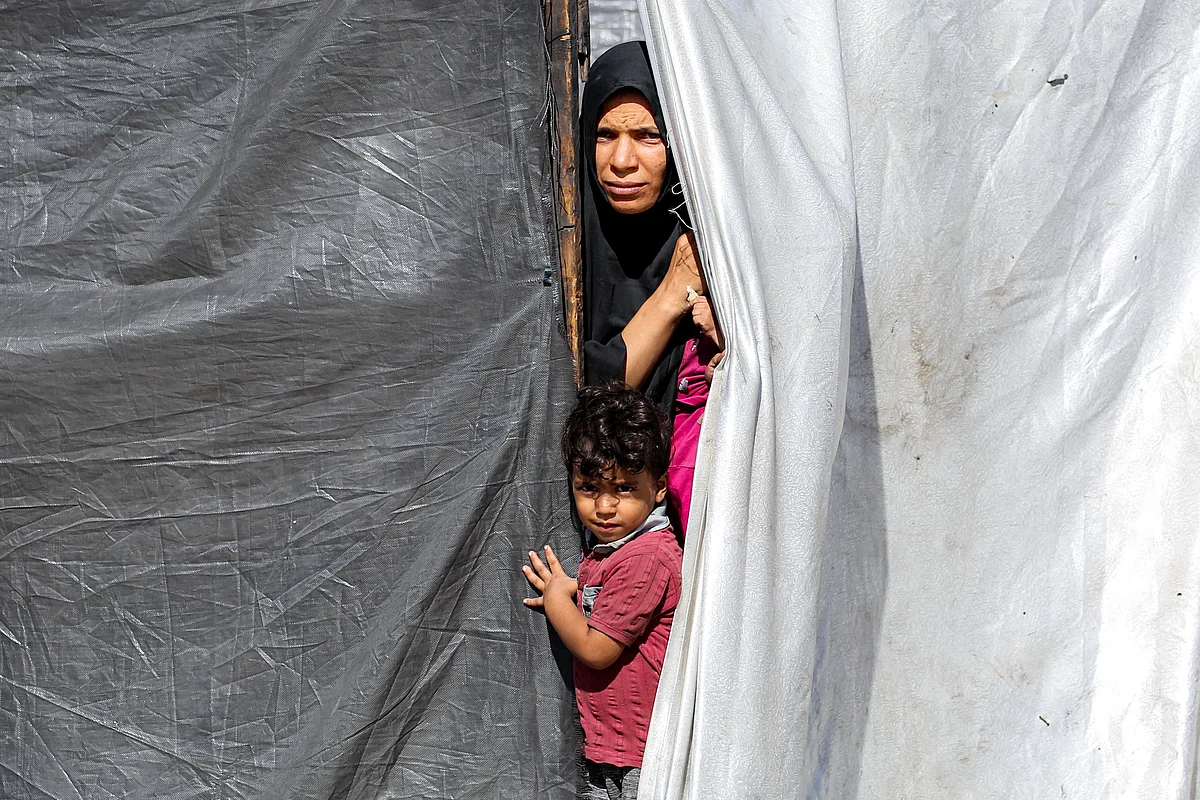
Gaza Boy In Dubai Still Haunted By War WHO Warns Of Lasting Scars
Two years have passed but the horrors of war in Gaza still haunt eight-year-old Palestinian boy, Yahya. There were times he would wake up in the middle of the night, sweating and running anxiously to his mother after hearing the sound of planes landing and taking off from the nearby airport.
“Even the sound of a whirring metallic electric fan can sometimes bring my young son to tears as it sounded like attack drones,” Yahya's mother told Khaleej Times. "'Are we being followed by Israeli fighter planes?', my son would ask me.”
Recommended For YouYahya, his six siblings, and mother (a Filipina married to a Palestinian) have been living in the UAE, following a circuitous and dangerous route to safety. Their home in Gaza was among the first to be razed to the ground by Israeli forces in mid-October 2023. Escaping heavy bombardment, they left their house with nothing but the clothes they were wearing, plus mismatched slippers, and a bag containing their passports. They were first evacuated by the Philippine government back in November 2023, then lived for a couple of months at a shelter house with other Palestinian refugees in a suburb near Manila, before they arrived in Dubai in January 2024.
Stay up to date with the latest news. Follow KT on WhatsApp Channels.
“Yes, my children are now safe, but the horrors of war still haunt them," Yahya's mother told Khaleej Times back then, and yet, 21 months later, Yahya - at his young age - is still struggling to find peace.
Wounds of warThere are tens of thousands more like Yahya, whose wounds of war - physically and psychologically - will take years to heal. In fact, the recent report by the World Health Organization (WHO) revealed“nearly 42,000 people in the Gaza Strip have life-changing injuries caused by the ongoing conflict.”
Worse, one in four of these injuries happened to children.“Gaza's many injured will need rehabilitation care and support for years to come,” the WHO report underscored.
The latest findings are striking and support the original 2024 WHO report. Here is the breakdown: Life-changing injuries account for one quarter of all reported injuries, from a total of 167,376 people injured since October 2023.
More than 5,000 people have faced amputation. Other severe cases include injuries to arms and legs (22,000+), spinal cord (2,000+), brain (1,300+), and major burns (3,300+). There is also an increasing number of complex facial and eye injuries, especially amongst patients listed for medical evacuation outside Gaza, conditions often leading to disfigurement, disability, and social stigma, WHO noted.
Rehabilitation services, like all health services in Gaza,“are under enormous strain, with no service fully operational, and a total loss of two thirds of pre-existing services," WHO noted. "Remaining services are now augmented by Emergency Medical Teams (EMTs) and partners, but even with this surge support, supplies are constrained, and overall rehabilitation capacity in Gaza remains well below pre-conflict levels.”
Brink of collapse“As new injuries mount and health needs rise, the health system teeters on the brink of collapse,” WHO noted.“Only 14 of Gaza's 36 hospitals remain partially functional, while less than one-third of pre-conflict rehabilitation services are operating, with several facing imminent closure. None are fully functional despite the efforts of EMTs and health partners.”
Doctors and medical workers toil in dangerous situations. According to WHO, Gaza once had around 1300 physiotherapists and 400 occupational therapists, but many have been displaced, and at least 42 have been killed. Those providing care are experiencing extreme stress and suffering. Despite the huge number of amputations, Gaza has only eight prosthetists to manufacture and fit artificial limbs.
“Displacement, malnutrition, disease, and the lack of assistive products mean that the true rehabilitation burden in Gaza is far greater than the figures presented,” noted Dr Richard Peeperkorn, WHO representative in the occupied Palestinian territory.“Conflict-related injuries also carry a profound mental health toll, as survivors struggle with trauma, loss, and daily survival while psychosocial services remain scarce. Mental health and psychosocial support must be integrated and scaled up alongside rehabilitation.”
'Urgent need to end war'The latest WHO report only focused on the number of injuries and the numbers could actually go higher as the“quantification of injuries in Gaza remains exceptionally challenging due to the ongoing conflict.”
There was also no mention of casualties, but the Palestinian Ministry of Health said on October 6 - two days before US President Donald Trump announced that Israel and Hamas have agreed to the first phase of a ceasefire in Gaza - that the death toll has climbed to 67,160, with nearly a third of the dead under the age of 18.
WHO, meanwhile, noted,“Gaza's fragile rehabilitation system was already inadequate to meet population needs before the current escalation. An additional 1.9 per cent of the population now lives with a potentially life-changing injury, and this number continues to rise. While an end to the conflict is urgently needed, without immediate and substantial investment across the system, thousands will remain without the care required to recover, reintegrate, and rebuild their lives.

Legal Disclaimer:
MENAFN provides the
information “as is” without warranty of any kind. We do not accept
any responsibility or liability for the accuracy, content, images,
videos, licenses, completeness, legality, or reliability of the information
contained in this article. If you have any complaints or copyright
issues related to this article, kindly contact the provider above.
Most popular stories
Market Research

- Pepeto Presale Exceeds $6.93 Million Staking And Exchange Demo Released
- Citadel Launches Suiball, The First Sui-Native Hardware Wallet
- Luminadata Unveils GAAP & SOX-Trained AI Agents Achieving 99.8% Reconciliation Accuracy
- Tradesta Becomes The First Perpetuals Exchange To Launch Equities On Avalanche
- Thinkmarkets Adds Synthetic Indices To Its Product Offering
- Edgen Launches Multi‐Agent Intelligence Upgrade To Unify Crypto And Equity Analysis



















Comments
No comment